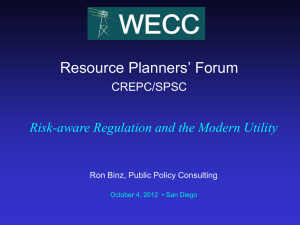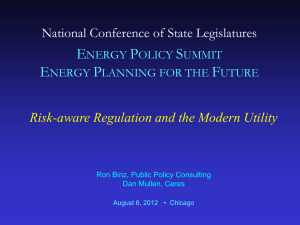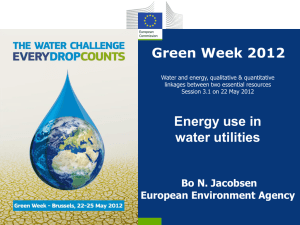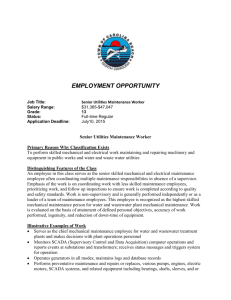Utilities - Career Cornerstone Center
advertisement
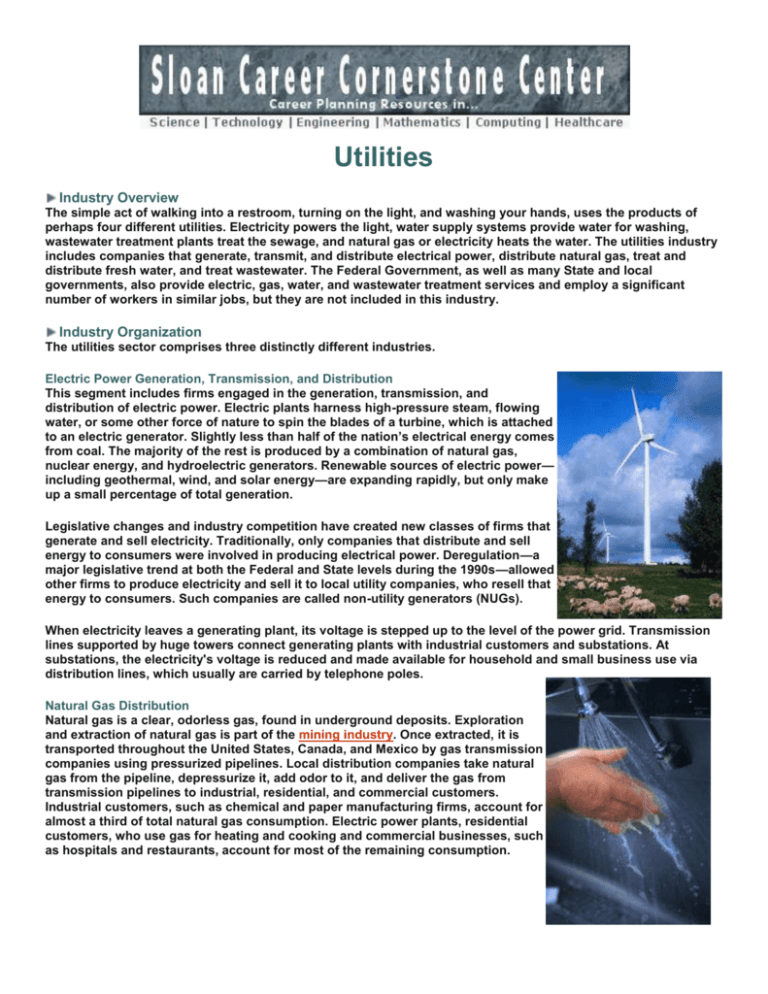
Utilities Industry Overview The simple act of walking into a restroom, turning on the light, and washing your hands, uses the products of perhaps four different utilities. Electricity powers the light, water supply systems provide water for washing, wastewater treatment plants treat the sewage, and natural gas or electricity heats the water. The utilities industry includes companies that generate, transmit, and distribute electrical power, distribute natural gas, treat and distribute fresh water, and treat wastewater. The Federal Government, as well as many State and local governments, also provide electric, gas, water, and wastewater treatment services and employ a significant number of workers in similar jobs, but they are not included in this industry. Industry Organization The utilities sector comprises three distinctly different industries. Electric Power Generation, Transmission, and Distribution This segment includes firms engaged in the generation, transmission, and distribution of electric power. Electric plants harness high-pressure steam, flowing water, or some other force of nature to spin the blades of a turbine, which is attached to an electric generator. Slightly less than half of the nation’s electrical energy comes from coal. The majority of the rest is produced by a combination of natural gas, nuclear energy, and hydroelectric generators. Renewable sources of electric power— including geothermal, wind, and solar energy—are expanding rapidly, but only make up a small percentage of total generation. Legislative changes and industry competition have created new classes of firms that generate and sell electricity. Traditionally, only companies that distribute and sell energy to consumers were involved in producing electrical power. Deregulation—a major legislative trend at both the Federal and State levels during the 1990s—allowed other firms to produce electricity and sell it to local utility companies, who resell that energy to consumers. Such companies are called non-utility generators (NUGs). When electricity leaves a generating plant, its voltage is stepped up to the level of the power grid. Transmission lines supported by huge towers connect generating plants with industrial customers and substations. At substations, the electricity's voltage is reduced and made available for household and small business use via distribution lines, which usually are carried by telephone poles. Natural Gas Distribution Natural gas is a clear, odorless gas, found in underground deposits. Exploration and extraction of natural gas is part of the mining industry. Once extracted, it is transported throughout the United States, Canada, and Mexico by gas transmission companies using pressurized pipelines. Local distribution companies take natural gas from the pipeline, depressurize it, add odor to it, and deliver the gas from transmission pipelines to industrial, residential, and commercial customers. Industrial customers, such as chemical and paper manufacturing firms, account for almost a third of total natural gas consumption. Electric power plants, residential customers, who use gas for heating and cooking and commercial businesses, such as hospitals and restaurants, account for most of the remaining consumption. Water, Sewage, and Other Systems Water utilities treat and distribute tap water for use by business and residential customers. Water is collected from rivers, lakes, and wells. After collection, water is treated and sold for residential, industrial, agricultural, commercial, and public use. Depending on the population served by the water system, the utility may be a small plant in a rural area that requires the occasional monitoring of a single operator or a huge system of reservoirs, dams, pipelines, and treatment plants requiring the coordinated efforts of hundreds of people. Sewage treatment facilities operate sewer systems or plants that collect, treat, and dispose of waste from homes and industries. Although standards for sewage are not as high as those for tap water, these utilities are responsible for removing harmful chemicals and microbes from wastewater before it can be released into the environment. Other systems include steam and air-conditioning supply utilities, which produce and sell steam, heated air, and cooled air. The services provided by the utilities industry are heavily regulated. In most places, they operate as monopolies because it is generally not desirable to have several competing systems of pipes or power lines in a single area. Public utility commissions ensure that companies act in the public interest and often set the rates that utilities are allowed to charge. In recent years, however, legislative changes have established and promoted competition in parts of the utilities industry where it is feasible. This is especially prevalent in the electric power industry, where wholesale providers of electricity now face competition from a number of non-utility generators. The various segments of the utilities industry vary in the degree to which their workers are involved in production activities, administration and management, or research and development. Industries such as water supply, that employ relatively few workers, employ more production workers and plant operators. On the other hand, electric utilities generally operate larger plants using very expensive, high technology equipment, and thus employ more professional and technical personnel. The utilities industry is unique in that urban areas with many inhabitants generally have relatively few utility companies. For example, there were about 52,000 community water systems in the United States in 2008 serving more than 292.3 million people. The 29,100 smallest water systems served only 4.9 million people while the 400 largest systems served more than 133.1 million. This shows that economies of scale in the utilities industry allow a few large companies to serve large numbers of customers in metropolitan areas more efficiently than many smaller companies. In fact, some utility companies, predominately serving large metropolitan areas, offer more than one type of utility service to their customers. Unlike most industries, the utilities industry imports and exports only a small portion of its product. To some degree, this is because transporting electricity, fresh water, and natural gas are somewhat challenging. It also is the result of a national policy that utilities should be self-sufficient, without dependence on imports for the basic services our country requires. However, easing trade restrictions, increased pipeline capacity, and shipping natural gas in liquefied form have made international trade in utilities more feasible, especially with Canada and Mexico. Recent Developments Energy policy is one of the key issues facing policy makers today. Issues such as energy security, pollution, greenhouse gas emissions, and toxic waste disposal are debated regularly in Congress. In both 2005 and 2007, Congress promoted conservation by passing new energy legislation that created subsidies for clean technologies. The expansion of nuclear power also is a major topic of discussion, and several new plants have received building permits, although none have began construction. The fastest-growing segment of the electric power industry is renewable energy. While renewables only make up a relatively small piece of the Nation’s energy mix, both wind and solar energy are expanding rapidly and, companies engaged in the production and installation of, are hiring a significant number of new workers. The natural gas industry also is evolving. While the share of natural gas being consumed by residential households and businesses has reached a near-term plateau, consumption by other sectors continue to increase. Many new natural gas power plants are being built, as natural gas is a cleaner alternative to coal. Further, natural gas is being used by some alternative fuel vehicles, although not enough to constitute a significant source of demand yet. At the same time, industry has reduced its share of overall natural gas usage over the last ten years. Though natural gas prices have stayed volatile in the past decade, employment has remained relatively stable as distributors earn their profits by charging set monthly rates rather than charging by volume delivered. The water and sewage systems industry continues to face challenges. As urban areas continue to grow and demand greater amounts of water, sources of fresh water are being exhausted. At the same time, companies are having difficulty complying with Federal and State water quality regulations. In many areas, aging infrastructure is a significant problem, and will have to be replaced during the projection period. All utilities continue to be affected by the anticipated baby boom retirements, which are expected to dramatically reduce the supply of domestic utility workers. As a result, the utilities industry is teaming up with universities, community colleges, and trade schools to train new workers and prepare the utility workforce of the future. Working Environment Electricity, gas, and water are used continuously throughout each day. As a result, split, weekend, and night shifts are common for many utility workers. The average weekly hours worked for production workers in utilities was 42.7 hours in 2008, compared with 33.2 hours for all trade, transportation, and utilities industries, and 33.6 hours for all private industries. At times, some employees must work overtime to accommodate peaks in demand and to repair damage caused by storms, cold weather, accidents, and other occurrences. The industry employs relatively few part-time workers. Work environment. The hazards of working with electricity, natural gas, treatment chemicals, and wastes can be substantial, but generally are avoided by following rigorous safety procedures. Protective gear such as rubber gloves and rubber sleeves, non-sparking maintenance equipment, and body suits with breathing devices designed to filter out any harmful fumes are mandatory for work in dangerous environments. Employees also undergo extensive training on working with hazardous materials and utility company safety measures. Employment Utilities had 559,500 wage and salary jobs in 2008. Electric power generation, transmission, and distribution provided about 404,700 jobs. The diversity of production processes in the utilities industry was reflected in the size of the establishments that made up the industry. For example, the electric power and natural gas distribution sectors consisted of relatively large plants. In 2008, electric power generation, transmission, and distribution plants employed an average of about 50 workers per establishment. On the other hand, the water, sewage, and other systems sector employed an average of only 8 workers per establishment. Although many establishments are small, the majority of utilities jobs were in establishments with 100 or more workers. STEM Degree Paths into this Industry Professional and related occupations in this industry include engineers and computer specialists. Engineers develop technologies that allow, for example, utilities to produce and transmit gas and electricity more efficiently and water more cleanly. They also may develop improved methods of landfill or wastewater treatment operations in order to maintain compliance with government regulations. Computer specialists develop computer systems to automate utility processes; provide plant simulators for operator training; and improve operator decision making. Engineering technicians assist engineers in research activities and may conduct some research independently. Managers in the utilities industry plan, organize, direct, and coordinate company activities. They often are responsible for maintaining negotiations with government regulators, labor organizations and suppliers. Industry Forecast Employment in utilities is expected to decline; nevertheless many job openings will arise because large numbers of many workers in the industry are approaching retirement age and will need to be replaced. Wage and salary employment in utilities is expected to decline 11 percent between 2008 and 2018, compared with an increase of 11 percent for all industries combined. Projected employment change varies by industry segment, as shown in table 4. Although electric power and natural gas continue to be essential to everyday life, the increased size and efficiency of new power plants will lead to an overall decline in employment. Water, sewage, and other systems segment of the industry, however, will continue to grow as the population of the country increases and urban areas expand. Employment in the electric power generation, transmission, and distribution industry is expected to decline by about 15 percent over the 2008-2018 period. Although the demand for electricity continues to increase over time, deregulation has led to greater cost-cutting measures that will allow power generation companies to be profitable in a competitive marketplace. As older, less efficient plants are retired, they are being replaced with new plants that have higher capacities and require fewer workers. Because the capacity of the new plants is higher, fewer are needed to produce the same amount of electricity. Nevertheless, some segments within electric power generation are likely to increase employment, such as nuclear power, electric transmission, and renewable energy. Should State and Federal Governments continue offering incentives to companies utilizing these technologies, employment should grow even more unimpeded. The natural gas distribution industry is expected to decline 6 percent over the projections decade. Industry consolidation has significantly impacted this industry, a trend that is expected to continue. Use of newer, more automated equipment will result in fewer operators to monitor these systems. Water and sewage systems services are projected to grow 13 percent, as water systems are expanding rapidly and as the industry has not yet experienced the efficiency gains seen among other utilities. Additionally, regulatory changes have benefited this industry. While most water systems remain locally-operated and fairly small in scale, water quality standards for both drinking water and disposal of wastewater have been tightened for public health and environmental reasons, requiring more workers. While hiring freezes have been less common in water than in other parts of the industry, much of the water workforce is nearing retirement age. Despite overall declining employment, job prospects for qualified applicants entering the utilities industry are expected to be excellent during the next 10 years. As of 2008, about 53 percent of the utilities industry workforce is age 45 or older (table 5). Many of these workers will either retire or prepare to retire within the next 10 years. Because on-the-job training is very intensive in many utilities industry occupations, preparing a new workforce will be one of the industry’s highest priorities during the next decade. Related Degree Fields Civil Engineering Computer Engineering Electrical Engineering Engineering Engineering Technology Environmental Engineering Nuclear Engineering Statistics Professional Associations American Gas Association American Nuclear Society American Public Power Association American Water Works Association American Wind Energy Association Nuclear Energy Institute Solar Electric Power Association US Office of Nuclear Energy, Science, and Technology Note: Some resources in this section are provided by the US Department of Labor, Bureau of Labor Statistics.
